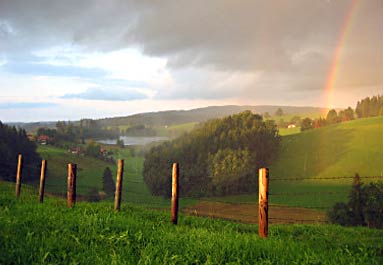



|

What should a seller do with a low-ball offer?
By Curtis Seltzer
In a sour market, sellers should anticipate discounting their asking prices and receiving discounted offers. The odd thing, however, is that in many areas of the country rural property -- particularly recreational tracts, farms and timberland -- has not been noticeably discounted in asking prices during the last two years. Some sales occur at these 2006-2007 prices, but it seems that a lot of properties are not moving.
Sellers who are holding out for close to their price have the ability to wait. That’s a fortunate position to be in.
A buyer, of course, does not know whether a seller is willing to come off his price significantly or whether the seller can hold indefinitely. The only way to find out is to make an offer.
I took a short look at two small timber tracts recently, one in New York, the other in West Virginia.
The New York property is 65 acres, priced at $54,900, or $845/A. No improvements. Accessed by a public jeep-trail road about a mile long that is plowed about half-way in the winter. Timbered about 10 years ago to a 14” diameter. Minerals convey. Warranty deed. No easements over the property. Electricity about ? mile away. Clean title. New York taxes are very high, and since this property was currently part of a larger tract, the amount of current tax is unknown.
This property has potential as a retirement investment. It has a good stand of 16-18” diameter sugar maple, red maple, cherry and ash, with a site index of about 70. No current cruise was done, but the broker-forester’s opinion was that the hardwood sawtimber in the 16”+ classes would run about 1,500 board feet per acre. He put a value on the sawtimber at about $20,000 to $25,000, at current knocked-down stumpage prices.
The purchase price about five years ago was about $100,000 for 260 acres, or $385/A.
I could see no reason that this type of property would have increased much in value since 2005 and considering the 25-year wait for the next timber harvest. Its main asset was timber, which was worth less today than when the seller bought it despite growth. As a smaller acreage, the 65 acres might be worth $500 to $600/A to an IRA-type investor. Maybe it’s worth $845 to an inexperienced buyer from New York City who is still working on Wall Street.
I put $475/A orally on the table to the broker who told me to get lost. He should have said, “Put it in writing.” I would have gone higher, maybe high enough.
The West Virginia property was 70 acres, priced at $105,000, or $1,500/A. It was not in one of the state’s garden spots. Minerals did not convey—a discount factor in an O&G field. An honest cruise done in 2005 when the current owners bought it showed about 320,000 bf in hardwood saw 12” DBH+, valued fairly then at $45,000. A harvest of the 16”+ saw would have brought in $35,000 to $44,000, the forester said. The owners had paid $900/A, or $63,000. No timbering had occurred since the 2005 purchase.
My consulting forester honestly valued the current sawtimber 12”+ at $32,000 as a clearcut and $23,000 as a select, DBH cut at 12”.
I calculated the seller paid 140 percent ($63,000) for the property of the then $45,000 merchantable timber value. So I told the broker that 140 percent of the current merch value of $32,000 was $44,800. I said I was simply following the same reasoning that the seller had used.
Again, I was willing to go higher. But the seller told the broker he wasn’t interested in negotiations.
Since it costs a seller next to nothing to look at a written offer and test the buyer’s willingness to increase it, both sellers may have passed up a deal because they didn’t want to evaluate the firmness of a low-ball offer submitted to over-priced listings.
Some low-balls never move, but others are meant to establish room for negotiations. Sellers don’t know which they face unless they look at an offer and respond.
Curtis Seltzer is a land consultant who works with buyers and helps sellers with marketing plans. He is author of How To Be a DIRT-SMART Buyer of Country Property at www.curtis-seltzer.com where his weekly columns are posted. He also writes for www.landthink.com.
|
|









